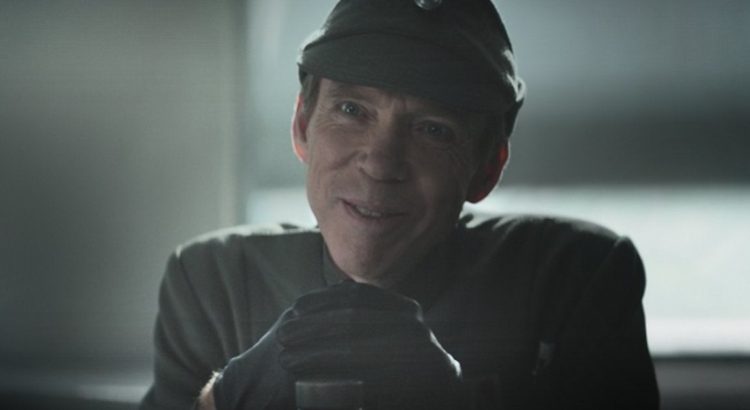Star Wars has always been known for strong anti-imperial themes, and these powerful political messages are particularly apparent in The Mandalorian. In this piece, I’ll explain how Din Djarin’s interactions with the Tusken Raiders, an Indigenous alien race, could provide important lessons to consider regarding the treatment of native communities. Even though Star Wars has tended to depict the Tuskens as being dangerous and monster-like, The Mandalorian shows they are actually a complex, dynamic and even vulnerable species. I’ll go on to explore how the show demonstrates the importance of coalition building, and shows the dangers of imperialism and war as embodied by those who lead the Empire.
Last year, I touched on the mistakes of the Republic as depicted in The Clone Wars – how its indifference to the suffering of ordinary people, and insidious expansion of imperialism, helped to create the Empire. Before that, another piece on colonialism by Abigail Dillon (that every fan should read) discussed why the role of Ezra in Star Wars Rebels was so powerful because he served as one of the first main heroes to firmly position themselves against the dangerous colonial points of views embodied by other characters. Like Ezra, I think Din is a continuation of fan-favorite characters representing a more recent tradition of Star Wars, particularly under the direction of Dave Filoni, that critically engages with themes of colonization at the narrative’s core in ways we haven’t seen before.
The first main interaction with Indigenous communities in The Mandalorian is in the fifth episode of season one, “The Gunslinger”, where Din works with Toro Calican, a young, naïve bounty hunter on Tatooine. In their trek the characters come across the native Tusken Raiders, whom Toro describes as “filth” that were standing in their way. Din, on the other hand, explains that they are Indigenous locals and the two of them are considered trespassers in the view of the Tuskens. Rather than engaging with them in a way that would antagonize the native race of aliens who had resided on the land for thousands of years, Din negotiates their passage using sign language and trades safe passage in return for equipment.
The Tusken Raiders return in the premiere of season two, “The Marshal”. In this story, Din stumbles upon the village of Mos Pelgo, home to a community of people who suffered under the occupation of the Empire. The village’s marshal Cobb Vanth was able to help liberate the community, but they still faced instability due to raids by a neighboring krayt dragon.
While Din agrees to help Vanth get rid of the krayt dragon, he realizes they can’t take on the creature alone and reaches out to the local tribe of Tusken Raiders for their assistance. Here again, Din negotiates with the Tuskens, treating them with respect and dignity rather than resorting to the aggressive tone that Vanth preferred. We learn that Din is able to speak their language in addition to the sign language we saw him utilize in the first season. He shows respect for them by drinking their water, which is sacred to them – showing recognition of the value of their cultural traditions. The Tuskens then tell Din how the human settlers have taken their water and killed their own people. In response, Vanth gets defensive and calls them “monsters that can’t be reasoned with”, taking a fiercely colonial tone, and tells the tribe leader that he’ll “put a hole in him” unless he backs down.
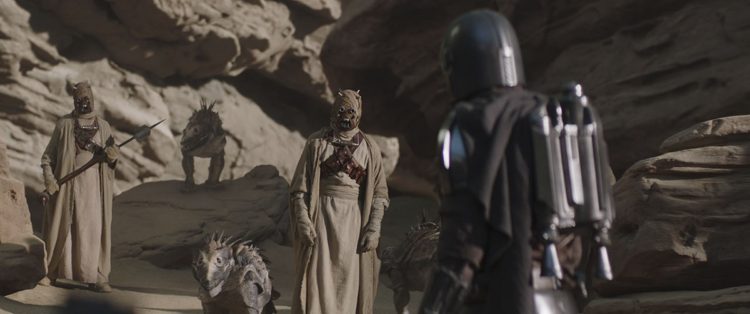
Throughout the conversation, Din repeatedly reminds Vanth to think from the perspective of the Tuskens, who have been suffering at the hands of outsiders in their land for lifetimes – facing aggression from the Empire, bad actors on Tatooine, and those who never respected their sovereignty. Din explains this in his speech to the villagers of Mos Pelgo when laying out the terms of the deal, despite pushback from members of the community who feel the Tuskens cannot be reasoned with. He says:
“The Tuskens are brutal, but so are the dunes (…) they are raiders, it’s true but they keep their word (…) they have survived for thousands of years in these sands and they know the krayt dragon better than anyone here.”
It’s important to note how racialized portrayals of the Tusken Raiders are contrasted with Din’s speech. In the imagination of everyday people in the universe (as well as that of Star Wars fans), the Tuskens are constantly dehumanized. Anakin slaughtered a whole village of them out of revenge in Attack of the Clones and called them “animals”; Toro said the settler locals referred to them as “filth”; and Vanth maintained they were monsters. But in reality, as Din shows us, the Tusken Raiders fight out of self-defense to safeguard their land, their scarce resources, and their very survival.
Perhaps we can learn lessons in our own world from the way that Din engages with this Indigenous tribe. Indigenous communities in the U.S. are at increased risk of contracting COVID-19, a circumstance which can be linked to conditions created by legacies of colonialism. Since the U.S. government has removed Native people from their lands and confined them to reservations, many were left with little access to healthcare and basic resources. Today, Native Americans disproportionately face poverty, worse healthcare outcomes, and higher rates of diseases of despair [1]A category of behavior-related medical conditions like suicide and drug and alcohol abuse, typically stemming from systemic poverty. than their white American counterparts. The repercussions of centuries of state violence are clearly apparent, and the solutions needed today must include putting Indigenous voices front and center. In the context of Star Wars, for example, the inclusion of more Indigenous storytellers could allow for them to touch on pressing issues facing their communities, helping highlight the lasting impacts of settler-colonialism.
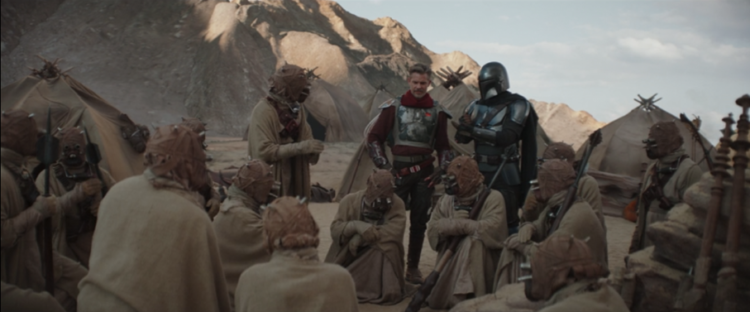
Moreover, inspiration for the Tusken Raiders was drawn from nomadic tribes across the Arab peninsula who faced similar issues of colonial rule. This can be connected to the Sykes-Picot treaty during World War I, which divided Indigenous Arab land into the control of Western powers for the exploitation of resources, wealth, and trade routes. The treaty carved out nation-states in the region, creating the modern “Middle East” with little say from local communities, displacing families in the process. Skyes-Picot can still be found in the roots of devastating regional conflicts in the Middle East today, such as the Iraq War, or in Yemen, Palestine, Iran, and Syria – where the U.S. continues to play a significant role.
In this context, one lesson to learn from Din’s example would be engaging the people in the region in a way that underscores diplomacy and justice, rather than force and domination; coming to terms with the reality that U.S. intervention has perpetuated suffering and instability for people in these countries would be an important step in creating a better future. Din’s emphasis on mutual respect and self-determination for Indigenous people could be a useful perspective from which to see those racialized as the “Other”.
In the penultimate episode of season two, “The Believer”, broader themes of empire, occupation, and war were brought to the forefront. The episode begins with Din and his team picking up Migs Mayfeld, a former bounty hunter and Imperial soldier, in hopes of finding the abducted Grogu. Mayfeld is incarcerated in a New Republic prison, and when Mando’s team finds him he is working in slave-labor conditions extracting resources in a garbage dump. What’s most surprising here is that the New Republic, which is meant by its founders to be the antithesis of what the Empire stands for, is engaging in dehumanizing practices similar to those the Imperials had a reputation for carrying out. The droid that keeps watch over Mayfeld not only addresses him by a number rather than by his name, but goes on to threaten to kill him if he doesn’t immediately comply with their demands.
Ultimately, Mayfeld does join the team and brings them to Morak, a planet with a secret Imperial mining base. Morak is shown to be home to native communities simply trying to survive. As Mayfeld and Din drive through a village while impersonating Imperial soldiers, Mayfeld remarks that to many in the galaxy it doesn’t matter who occupies their land. To these people, large powers who undermine their self-determination are invaders — whether they’re from the Empire or the New Republic.
It’s critical to recognize, however, that there can never be a true equivalency between the Empire and New Republic. One emerged to enforce a system of human supremacy, war crimes, and slavery, and the other is a multi-racial coalition that came forth to resist that system. The point stands, though, that the agency of Indigenous people should be prioritized over large outside powers, and the New Republic is hardly exempt from criticism given how we’ve seen it treat its prisoners.
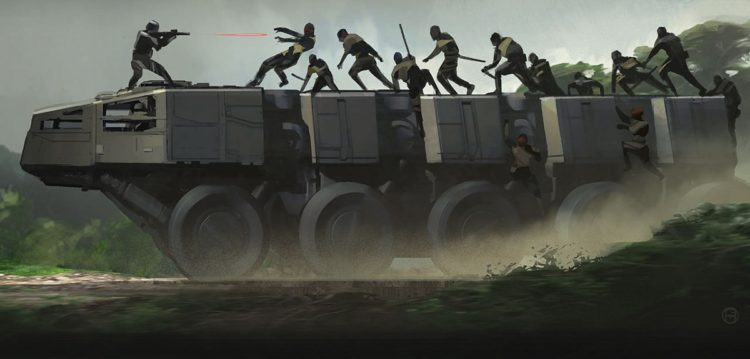
The most compelling part of the episode is Mayfeld’s tense conversation with his former commanding officer, Valin Hess, within the Imperial base. Hess exemplifies the abject cruelty and horror of the Empire’s fascist ideology. He argues that order and hierarchy should be prioritized over freedom, and the Empire must use fear to gain power and impose that order. Mayfeld, who fought at Burnin Konn (part of Operation Cinder – a bloody and genocidal campaign carried out by the Empire in its last days), questions the very meaning of the Empire’s ideological roots. Hess states that the thousands of civilian and military deaths resulting from the operation were a “sacrifice for the greater good” to restore stability to the galaxy. In response, Mayfeld says:
“All those people, the ones who died – was it good for them? Hmm? Their families, the guys I served with? Civilians, those poor mudscuffers, who died defending their homes, fighting for freedom? Was it good for them?”
Hess tells Mayfeld that the rhydonium, a powerful explosive the Empire is occupying the planet in order to mine, will be used in ways that make Burnin Konn “pale by comparison”, indicating plans to use mass violence and terror to foster a resurgence of the Empire. He brags that the New Republic is in disarray and it’s just a matter of time before they’re crushed. Holding back tears, Mayfeld finally kills Hess, and as they escape the planet he detonates the rhydonium so it can’t be used by the Empire in the future.
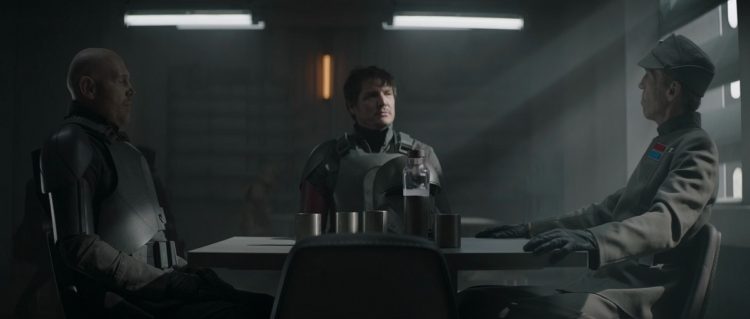
I think the political and philosophical themes of the conversation between Hess and Mayfeld strongly mirror those of U.S. foreign policy today. With a military budget akin to that of the next ten countries combined, hundreds of bases overseas, and a series of offensive wars that have been fought for “freedom and democracy”, what have the costs really been? According to studies by Brown University, the ongoing “War on Terror” has killed hundreds of thousands of people and left tens of millions more displaced, most of them from Muslim-majority countries. The substance of Mayfeld’s questioning of the Empire’s orthodoxy resonates squarely with the impacts of the American empire as well. This mantra is consistent throughout the saga, as Yoda not only told Luke that “wars do not make one great”, but he also explained to Ezra in Rebels how the Jedi’s involvement in the Clone Wars compromised their values:
“Padawan, thousands of Jedi once, there were. Then came war. In our arrogance, joined the conflict swiftly, we did. Fear, anger, hate. Consumed by the dark side, the Jedi were.”
Overall, I believe the takeaways here are that The Mandalorian seriously contemplates the devastating impacts of war and how “military might” is clearly not the best approach to solve conflicts given the consequences. Din’s cooperation with the Tusken Raiders brings attention to the colonialism they face and shows an alternative approach to interacting with them. From the beginning, Star Wars has maintained an anti-authoritarian legacy, showing us how militarism wielded for the furtherance of power can fatally erode democratic values. It also suggests the importance of resisting these forces of domination through an anti-imperial lens. We must further continue to stress that one big step in the right direction would be to provide a platform for writers who have been affected by empire to account for their own experiences, narratives, and histories. The Mandalorian, thanks to the work done by writers Rick Famuyima, Dave Filoni, and Jon Favreau, reveals the value of not just fighting against injustice but of uplifting the vulnerable and oppressed in the stories told. As a fan who tries to both embody and learn these lessons, I’m grateful to see it.
| ↑1 | A category of behavior-related medical conditions like suicide and drug and alcohol abuse, typically stemming from systemic poverty. |
|---|
